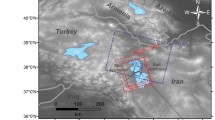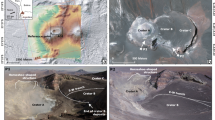Abstract
This paper presents deformation analysis of Lake Urmia causeway (LUC) embankments in northwest Iran using observations from interferometry synthetic aperture radar (InSAR) and finite element model (FEM) simulation. 58 SAR images including 10 ALOS, 30 Envisat and 18 TerraSAR-X are used to assess settlement of the embankments during 2003–2013. The interferometric dataset includes 140 differential interferograms which are processed using InSAR time series technique of small baseline subset approach. The results show a clear indication of large deformation on the embankments with peak amplitude of \(>\)50 mm/year in 2003–2010, increasing to \(>\!\!80\) mm/year in 2012–2013 in the line of sight (LOS) direction from ground to the satellite. 2D decomposition of InSAR observations from Envisat and ALOS satellites that overlap in the years 2007–2010 shows that the rate of the vertical settlement and horizontal motion is not uniform along the embankments; Both eastern and western embankments show significant vertical motion, while horizontal motion plays a more significant role in eastern embankment than western embankment. The InSAR results are then used to simulate deformation using FEM at two cross-sections at the distance of 4 and 9 km from the most western edge of the LUC for which detailed stratigraphy data are available. Results suggest that consolidation due to dissipation of excess pore pressure in embankments can satisfactory predict settlement of the LUC embankments. Our numerical modeling indicates that nearly half of the consolidation since the construction time of the causeway 30 years ago has been done.



















Similar content being viewed by others
References
Aly MH, Klein AG, Zebker HA, Giardino JR (2012) Land subsidence in the Nile Delta of Egypt observed by persistent scatterer interferometry. Remote Sens Lett 3:621–630
Anderssohn J, Motagh M, Walter TR, Rosenau M, Kaufmann H, Oncken O (2009) Surface deformation time series and source modeling for a volcanic complex system based on satellite wide swath and image mode interferometry: The Lazufre system, central Andes. Remote Sens Environ 113:2062–2075
Bell JW, Amelung F, Ferretti A, Bianchi M, Novali F (2008) Permanent scatterer InSAR reveals seasonal and long-term aquifer-system response to groundwater pumping and artificial recharge. Water Resour Res 44:W02407
Berardino P, Fornaro G, Lanari R, Sansosti E (2002) A new algorithm for surface deformation monitoring based on small baseline differential SAR interferograms. IEEE Trans Geosci Remote Sens 40:2375–2383
Biggs J, Bürgmann R, Freymueller JT, Lu Z, Parsons B, Ryder I, Schmalzle G, Wright T (2009) The postseismic response to the 2002 M 7.9 Denali Fault earthquake: constraints from InSAR 2003–2005. Geophys J Int 176:353–367
Colesanti C, Ferretti A, Prati C, Rocca F (2003) Monitoring landslides and tectonic motions with the permanent scatterers technique. Eng Geol 68:3–14
Fernández J, Tizzani P, Manzo M, Borgia A, Gonz\(\cdot \)lez PJ, MartÌ J, Pepe A, Camacho AG, Casu F, Berardino P, Prieto JF, Lanari R (2009) Gravity-driven deformation of Tenerife measured by InSAR time series analysis. Geophys Res Lett 36:L04306. doi:10.1029/2008gl036920
Ferretti A, Prati C, Rocca F (2001) Permanent scatterers in SAR interferometry. IEEE Trans Geosci Remote Sens 39:8–20
Fialko Y, Simons M, Agnew D (2001) The complete (3-D) surface displacement field in the epicentral area of the 1999 MW 7.1 Hector Mine Earthquake, California, from space geodetic observations. Geophys Res Lett 28:3063–3066
Hanssen R (2002) RADAR interferometry data interpretation and error analysis. KLUWER academic publishers ISBN: 978-0-7923-6945-5
Hooper A (2008) A multi-temporal InSAR method incorporating both persistent scatterer and small baseline approaches. Geophys Res Lett 35: doi:10.1029/2008GL034654
Hooper A, Zebker H, Segall P, Kampes B (2004) A new method for measuring deformation on volcanoes and other natural terrains using InSAR persistent scatterers. Geophys Res Lett 31:L23611. doi:10.1029/2004gl021737
Hooper A, Zebker HA (2007) Phase unwrapping in three dimensions with application to InSAR time series. J Opt Soc Am A 24:2737–2747
Hung W-C, Hwang C, Chen Y-A, Chang C-P, Yen J-Y, Hooper A, Yang C-Y (2010) Surface deformation from persistent scatterers SAR interferometry and fusion with leveling data: a case study over the Choushui river alluvial fan. Remote sensing of environment, Taiwan. doi:10.1016/j.rse.2010.11.007
Jones CA, Stewart DI, Danilewicz CJ (2008) Bridge distress caused by approach embankment settlement. Proceedings of the ICE - geotechnical engineering
Kampes B, Hanssen R, Perski Z (2003) Radar interferometry with public domain tools. In proceedings of FRINGE 2003. http://earth.esa.int/fringe03/proceedings/papers/22_kampes.pdf (Accessed 14 July 2014)
Karlsrud K (2006) Updated assessment of stability and settlement of the embankment. In Norwegian geotechnical institute (NGI)
Lanari R, Casu F, Manzo M, Lundgren P (2007) Application of the SBAS-DInSAR technique to fault creep: a case study of the Hayward fault, California. Remote Sens Environ 109:20–28. doi:10.1016/j.rse.2006.12.003
Lubitz C, Motagh M, Wetzel H-U, Kaufmann H (2013) Remarkable urban uplift in Staufen im Breisgau, Germany: observations from TerraSAR-X InSAR and leveling from 2008 to 2011. Remote Sens 5:3082–3100
Motagh M, Hoffmann Jr, Kampes B, Baes M, Zschau J (2007) Strain accumulation across the Gazikoy-Saros segment of the North Anatolian fault inferred from persistent scatterer interferometry and GPS measurements. Earth Planet Sci Lett 255:432–444
Motagh M, Wetzel H-U, Roessner S, Kaufmann H (2013) A TerraSAR-X InSAR study of landslides in southern Kyrgyzstan, Central Asia. Remote Sens Lett 4:657–666. doi:10.1080/2150704x.2013.782111
Motagh M, Walter TR, Sharifi MA, Fielding E, Schenk A, Anderssohn J, Zschau J (2008) Land subsidence in Iran caused by widespread water reservoir overexploitation. Geophys Res Lett, vol 35. doi:10.1029/2008GL033814
Pritchard ME, Simons M (2002) A satellite geodetic survey of large-scale deformation of volcanic centres in the central Andes. Nature 418:167–171
Samsonov S, Tiampo K, Gonz\(\cdot \)lez PJ, Manville V, Jolly G (2010) Ground deformation occurring in the city of Auckland, New Zealand, and observed by Envisat interferometric synthetic aperture radar during 2003–2007. J Geophys Res 115:B08410. doi:10.1029/2009JB006806
Schmidt DA, Bürgmann R (2003) Time-dependent land uplift and subsidence in the Santa Clara valley, California, from a large interferometric synthetic aperture radar data set. J Geophys Res, vol 108. doi:10.1029/2002jb002267
Shamshiri R, Motagh M, Baes M, Sharifi MA. (2014). Supplement to: deformation analysis of the Lake Urmia Causeway (LUC) embankments in northwest Iran: insights from multi-sensor interferometry synthetic aperture radar (InSAR) data and finite element modeling (FEM). In, German Res. Centre for Geosci., GFZ, Potsdam, Germany [Online]. doi:10.5880/GFZ.1.4.2014.001
Strozzi T, Farina P, Corsini A, Ambrosi C, Thüring M, Zilger J, Wiesmann A, Wegmüller U, Werner C (2005) Survey and monitoring of landslide displacements by means of L-band satellite SAR interferometry. Landslides 2:193–201
Acknowledgments
We would like to thank the European Space Agency (ESA) for supplying the Envisat and ALOS images through the category 1 projects AOALO3740 and C1P2892 and the German Aerospace Agency (DLR) for acquiring and providing TerraSAR-X data under the research project GEO0179. We also thank Mr. Shahinpar from SADRA Company for providing information on soil parameters, leveling measurements and lake level data. The authors are grateful to two anonymous reviewers and the Editor, Masato Furuya, for their insightful comments and suggestions that helped improve the quality of the manuscript.
Author information
Authors and Affiliations
Corresponding author
Rights and permissions
About this article
Cite this article
Shamshiri, R., Motagh, M., Baes, M. et al. Deformation analysis of the Lake Urmia causeway (LUC) embankments in northwest Iran: insights from multi-sensor interferometry synthetic aperture radar (InSAR) data and finite element modeling (FEM). J Geod 88, 1171–1185 (2014). https://doi.org/10.1007/s00190-014-0752-6
Received:
Accepted:
Published:
Issue Date:
DOI: https://doi.org/10.1007/s00190-014-0752-6




